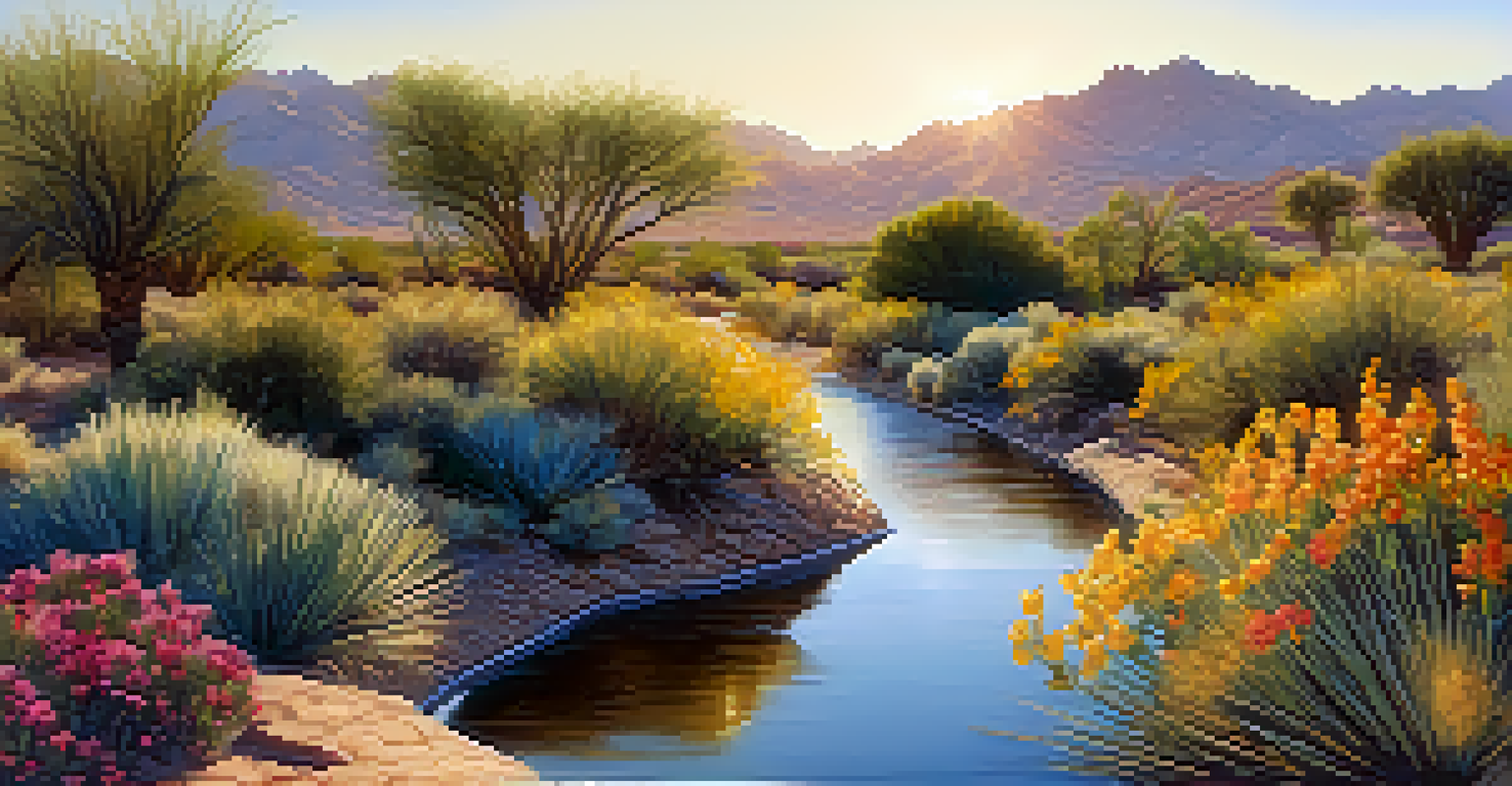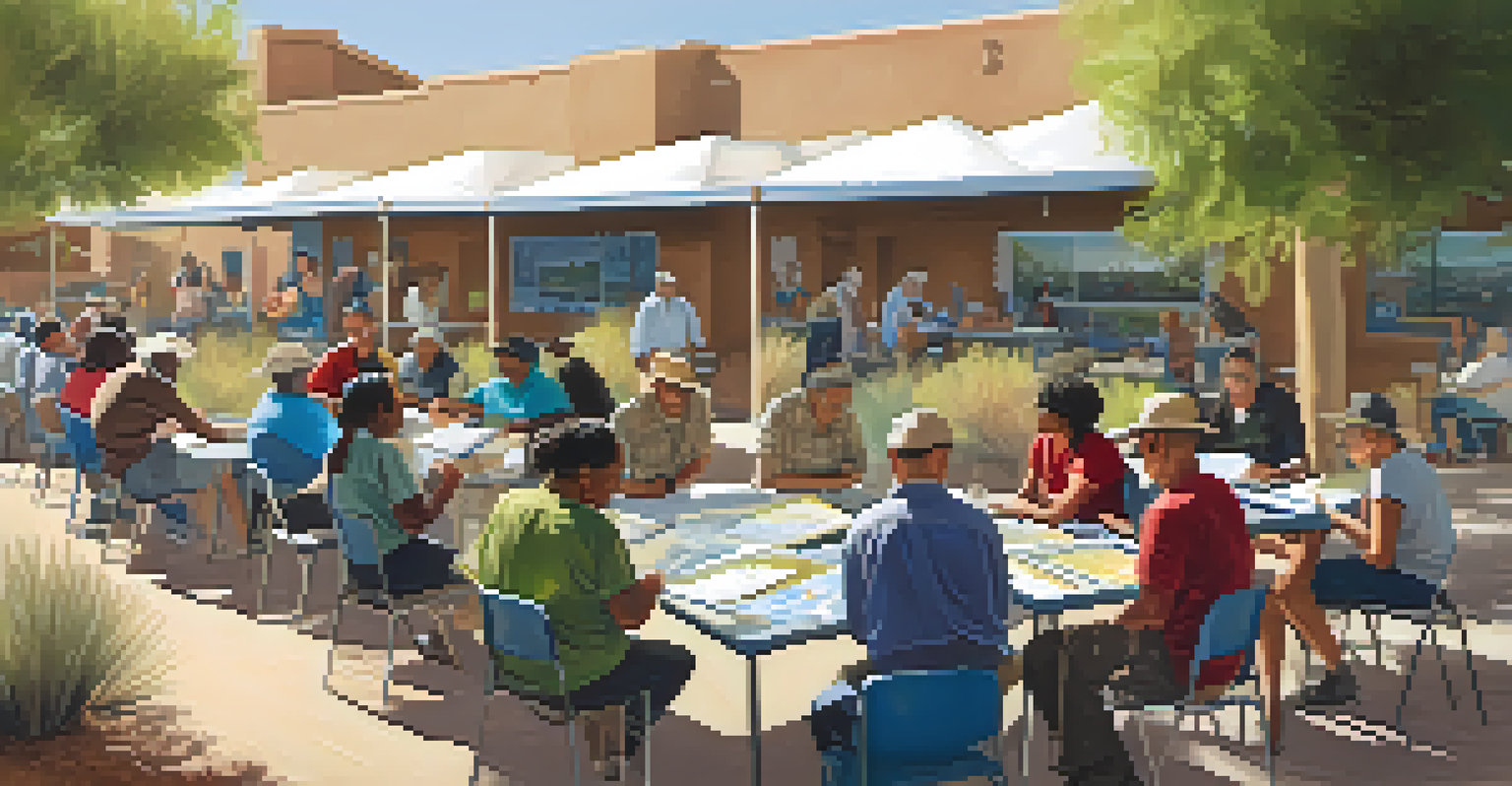Historical Overview of Water Conservation in Tucson, Arizona

The Arid Landscape: Understanding Tucson's Water Challenges
Tucson, Arizona, is nestled in a desert landscape characterized by arid conditions and scarce water resources. This environment has shaped the city's history and its approach to water management. The challenges posed by limited rainfall and high evaporation rates have necessitated innovative solutions over the years.
Water is the driving force of all nature.
In the early days, indigenous peoples, such as the Hohokam, showcased remarkable water management strategies by constructing extensive canal systems. These canals allowed them to divert water from rivers, enabling agriculture in an otherwise inhospitable region. Their practices laid the groundwork for future generations to understand the importance of water conservation.
As Tucson grew, so did the demand for water, prompting the need for more sophisticated conservation methods. The city's historical context is essential for grasping how residents have always been keenly aware of their precious water resources.
Early Innovations: The Hohokam Canal System
The Hohokam people were pioneers in water conservation, developing an extensive canal system over 1,500 years ago. These canals not only provided irrigation for their crops but also demonstrated an early understanding of sustainable water management. By carefully managing water flow, the Hohokam cultivated a thriving agricultural economy in the desert.

These early water conservation efforts exemplified a deep respect for the environment, as the Hohokam learned to work with the land rather than against it. Their techniques, which included the use of check dams and other water retention systems, influenced future generations in Tucson. The legacy of their ingenuity can still be seen in modern conservation practices.
Tucson's Historical Water Management
Tucson's water management practices have evolved from the Hohokam's ancient canal systems to modern conservation techniques driven by community engagement.
Understanding the Hohokam's approach to water is crucial for appreciating the ongoing efforts in Tucson to manage water wisely. Their innovations remind us that sustainable practices have deep historical roots in this desert city.
The Impact of Spanish Colonization on Water Practices
When Spanish colonizers arrived in the 18th century, they brought new agricultural practices and water management techniques. They adapted the existing systems to fit their needs, introducing crops such as wheat and grapes, which required different water management strategies. This blending of cultures and practices marked a significant shift in Tucson's water conservation landscape.
The greatest threat to our planet is the belief that someone else will save it.
The Spanish established missions that relied on efficient irrigation methods, further developing the region's water infrastructure. Their influence contributed to a deeper understanding of the need for reliable water sources in Tucson. However, the introduction of these new practices also led to increased competition for water resources.
As a result, the need for effective water conservation became even more pressing during this period. The legacy of Spanish influence continues to resonate in Tucson’s water management practices today.
20th Century Developments: Infrastructure and Legislation
The 20th century marked a turning point in Tucson's approach to water conservation, with significant advancements in infrastructure and legislation. The construction of the Central Arizona Project in the 1970s allowed water from the Colorado River to be transported to Tucson, providing a much-needed supply for a growing population. This development prompted a rethink of water conservation strategies across the region.
Alongside infrastructure improvements, various laws and regulations were enacted to promote responsible water usage. The Groundwater Management Act of 1980 aimed to protect and enhance the region's groundwater supplies, emphasizing sustainable practices and renewable resources. These legislative measures reflected a growing awareness of the finite nature of water resources in the desert.
Innovative Water Conservation Practices
The city has embraced innovative methods like rainwater harvesting and greywater recycling to enhance water sustainability.
With these developments, Tucson began to embrace a more proactive stance on water conservation, setting a precedent for future generations. The combination of infrastructure and policy laid the foundation for a more sustainable approach to water management.
Innovative Practices: Rainwater Harvesting and Greywater Use
In recent years, Tucson has become a leader in innovative water conservation practices, such as rainwater harvesting and greywater recycling. These methods allow residents to capture and reuse water, reducing demand on municipal supplies. Rainwater harvesting systems can be as simple as a barrel under a downspout or as complex as a full irrigation system, making them accessible to various homeowners.
Greywater systems, which recycle water from sinks, showers, and laundry, have gained popularity as well. By diverting this water for landscape irrigation, Tucson residents can significantly reduce their overall water consumption. These practices not only conserve water but also encourage a more sustainable lifestyle.
Tucson's embrace of these innovative practices showcases the city's commitment to preserving its water resources for future generations. As community awareness of water conservation grows, so does the adoption of these eco-friendly solutions.
Community Education and Engagement in Water Conservation
Community education has played a vital role in Tucson's water conservation efforts. Programs aimed at raising awareness about the importance of saving water have become increasingly popular, empowering residents to take action. Workshops, school programs, and local events help spread the message about smart water use and conservation techniques.
Partnerships between government agencies, non-profits, and local businesses have strengthened these educational initiatives. By working together, they have created a network of resources and support for residents looking to reduce their water footprint. This community-driven approach fosters a sense of shared responsibility for water conservation.
Future Challenges and Solutions
As climate change and population growth intensify, Tucson's future water conservation efforts will focus on infrastructure enhancement and new technologies.
As more individuals become informed about their water usage, Tucson continues to see positive changes in conservation efforts. The collective action of the community highlights the importance of collaboration in addressing water challenges.
Looking Ahead: The Future of Water Conservation in Tucson
As Tucson faces ongoing challenges related to climate change and population growth, the importance of water conservation will only increase. Future efforts will likely focus on enhancing existing infrastructure, implementing new technologies, and promoting sustainable practices. Collaboration among stakeholders will be crucial to developing innovative solutions that address both current and future challenges.
The city is also exploring the potential of desalination and advanced water treatment technologies to diversify its water sources. These options could provide additional resilience against drought and water scarcity. By investing in research and development, Tucson can position itself as a leader in water management.

Ultimately, the future of water conservation in Tucson relies on the collective efforts of its residents, businesses, and government. By learning from the past and embracing new innovations, Tucson can continue to thrive in its arid environment, ensuring a sustainable water supply for generations to come.